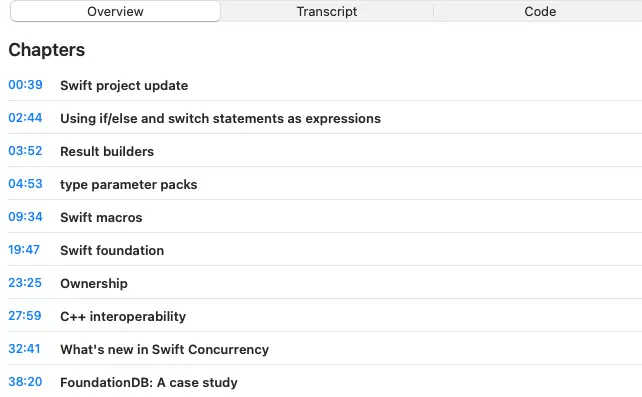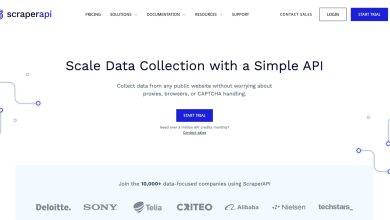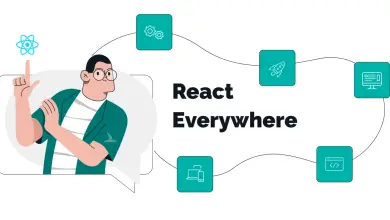
One other WWDC has come and gone, and there are such a lot of necessary and compelling session movies but to observe! Or at the least scan.
There are classes on our most necessary instruments: Swift, Xcode and SwiftUI. The brand new Observable and SwiftData frameworks will revolutionize how your apps deal with knowledge. Accessibility and localization bought some notable enhancements. And, in fact, everybody’s enthusiastic about Imaginative and prescient Professional and utilizing visionOS in the whole lot.
Kodeco Group members nominated a couple of different subjects as favorites: Widgets, Swift OpenAPI Generator, Push notifications console and Swift-DocC.
Right here’s a roundup of a very powerful movies from WWDC ’23. Watch them to make sure that you’re up-to-date with Apple’s most necessary adjustments this yr!
Swift, Xcode & SwiftUI
It’s all the time value scanning the What’s new classes. Even when you don’t begin utilizing all the brand new issues instantly, you’ll pay attention to what’s there, and also you’ll know what everybody else is speaking about on social media.
Swift
First up, What’s new in Swift.
The Chapters hyperlinks make it straightforward to leap straight to no matter sounds fascinating:
You will get a fast overview of the updates by scrolling by the code snippets:

Faucet straight into the video, and the transcript scrolls to match:

And you’ll search the transcript for particular phrases, then bounce proper into the video or take a look at the code.
Macros
Macros are the massive information in Swift, and so they underpin the massive information in SwiftUI and SwiftData. Listed below are two classes to get you began:
Additionally check out the macro repositories from Doug Gregor and Krzysztof Zabłocki.
Xcode
Subsequent, What’s new in Xcode 15 — your favourite IDE will get simpler to make use of yearly, with a great deal of productiveness enhancements like clever code completion, previews, take a look at navigator and take a look at reviews, improved navigation, supply management and debugging.
For instance, learn this SwiftLee article in regards to the new Xcode bookmarks:
[A] new function that means that you can save fast hyperlinks to code you need to revisit. Doing so means that you can save code landmarks and manage duties you must fulfill.
I can really feel my workflow shrinking already!
And, whether or not you’re keen on or hate unit and UI exams, you should definitely take a look at Repair failures quicker with Xcode take a look at reviews to find out about failure patterns, UI automation explorer and UI take a look at video recordings.
SwiftUI
SwiftUI retains getting higher and simpler to make use of.
What’s new in SwiftUI

There are enhancements to SwiftUI previews and new SwiftUI help for watchOS, MapKit, Charts and StoreKit, however the massive information right here is the brand new Statement framework described within the Simplified knowledge move chapter and in additional element in Uncover Statement in SwiftUI.
We’re again to only three property wrappers: @State, @Setting and the brand new @Bindable — a light-weight wrapper when you simply have to create a binding to an @Observable worth — say, to show it in a textual content area so the consumer can edit it.
Observable TIL
I’ll shortly stroll you thru changing the Mix-based ObservableObject protocol to @Observable in a quite simple app.
Click on Obtain supplies on the high or backside of this text to obtain the starter challenge. Open it in Xcode 15 beta. It will work in Xcode 14, however I’ve already set its iOS deployment goal and minimal deployment to 17.0.
TIL is easier than Apple’s FoodTruck app — it simply lets the consumer add acronyms, which it shows in a listing. Refresh the ContentView preview and add a few acronyms to see the way it works.

In ThingStore, change:
remaining class ThingStore: ObservableObject {
@Printed var issues: [Thing] = []
}
to this:
@Observable class ThingStore {
var issues: [Thing] = []
}
ObservableObject turns into @Observable, and any public properties might be printed. You’ll be able to mark an accessible property @ObservationIgnored when you don’t need it to be noticed.
Apple’s Notice: Utilizing the remaining key phrase is non-compulsory when making a category observable.
TIL doesn’t let the consumer edit an acronym after it’s created, so Factor doesn’t should be @Observable, and it may possibly stay a struct.
In AddThingView, change:
@ObservedObject var someThings: ThingStore
to this:
let someThings: ThingStore
In ContentView, change:
@StateObject personal var myThings = ThingStore()
to this:
let myThings = ThingStore()
You not want @ObservedObject or @StateObject. When AddThingView updates someThings.issues, ContentView will mechanically replace as a result of myThings is observable, and ContentView reads its issues array.
Refresh the preview, then add a couple of acronyms to see the app works the identical as earlier than, however now with slightly bit much less code.

Now, construct and run the app in a simulator. Add a few acronyms, then cease the operating app in Xcode. Reopen the app within the simulator: No Factors, no shock. The app has no persistence code.
SwiftData
No have to fiddle with writing and studying plists or recordsdata — or worse, grapple with un-Swifty Core Information: Meet SwiftData! Begin with this session, then dive deeper with these:
-
Mannequin your schema with SwiftData: Use
@Attributeto customise properties, arrange@Relationships with different@Mannequins, exclude properties out of your knowledge mannequin with@Transientand, when the time comes, migrate from one model of your schema to the following. - Construct an app with SwiftData: Work with a multi-platform SwiftUI app to transform current mannequin courses and replace the UI with mannequin layer adjustments. Additionally, discover ways to use SwiftData in document-based apps.
-
Dive deeper into SwiftData: Study
ModelContext,ModelContainer,FetchDescriptor,SortDescriptorand enumerate.
And, in case your apps already use Core Information, check out Migrate to SwiftData to discover ways to change to SwiftData or add it alongside your Core Information code.
TIL With SwiftData
And now, to transform TIL to make use of SwiftData. Proceed with the Observable model of TIL.
In TilApp, import SwiftData
import SwiftData
Then add this modifier to WindowGroup:
.modelContainer(for: Factor.self)
You create a mannequin container for the Factor mannequin kind. You may also move an array of mannequin sorts because the for parameter, to retailer multiple kind. Making a container additionally units a mannequin context within the setting for this container.
In ThingStore, import SwiftData then change Factor with this:
@Mannequin
class Factor {
// let id = UUID() // you should definitely delete this!
let brief: String
let lengthy: String
let alt: String
init(brief: String, lengthy: String, alt: String) {
self.brief = brief
self.lengthy = lengthy
self.alt = alt
}
}
Like @Observable, @Mannequin is a macro. It converts a category right into a saved mannequin managed by SwiftData.
You undoubtedly don’t need the id property anymore. It confuses the mannequin and produces wildly incorrect outcomes. And, now that Factor is a category, you want an initializer, even when you assign default values to all of the properties. The @Mannequin macro requires an init methodology.
Remark out ThingStore: The container and context deal with the whole lot.
In ContentView, import SwiftData then change this property:
let myThings = ThingStore()
with these two traces:
@Setting(.modelContext) personal var modelContext
@Question personal var myThings: [Thing]
You carry within the mannequin context and arrange a easy question to fetch the array of Factors.
Repair the error messages about myThings.issues by deleting .issues from myThings.issues:
if myThings.isEmpty {
And
ForEach(myThings) { factor in
Within the sheet(isPresented:) closure, delete the someThings argument:
AddThingView()
You don’t have a ThingStore anymore, and also you don’t must move something to AddThingView.
In AddThingView, change this line:
let somethings: ThingStore
With this:
@Setting(.modelContext) personal var modelContext
You carry within the mannequin context right here, too.
And, within the Accomplished button’s closure, change:
someThings.issues.append(Factor(brief: brief, lengthy: lengthy, alt: alt))
With mannequin context code:
let newThing = Factor(brief: brief, lengthy: lengthy, alt: alt)
modelContext.insert(newThing)
In #Preview, delete the someThings argument.
Now, again in ContentView, add this modifier in #Preview:
ContentView()
.modelContainer(for: Factor.self, inMemory: true)
Refresh the preview and add a couple of acronyms to see the app works the identical as earlier than. Now, for the magic: Construct and run in a simulator, add a couple of Factors, then cease the operating app in Xcode. Reopen the app within the simulator to see your Factors are nonetheless there!

Accessibility & Localization

You’ll be able to develop the viewers in your app by making it accessible to folks with — usually non permanent — particular wants, in addition to customers who need to work together along with your app in a language aside from English. Listed below are some classes it’s best to take a look at:
visionOS
Final however definitely not least is the tremendous framework that helps the Imaginative and prescient Professional juggernaut. Most of this yr’s WWDC classes are about some side of making or adapting apps to be Imaginative and prescient Professional-ready. By default, all apps will run on Imaginative and prescient Professional so, in case you have cashed-up customers, they’ll be demanding enhanced UI and consumer experiences for them to get pleasure from / enhance their productiveness.

Search the classes for “imaginative and prescient” and “spatial”. Listed below are a couple of classes to get you began:
Honorable Point out
Widgets

Widgets at the moment are in all places! They’re additionally interactive and have a brand new dwelling on Apple Watch — Sensible Stack:
Swift OpenAPI Generator
Meet Swift OpenAPI Generator: Generates mannequin code from an OpenAPI doc, changing websites like quicktype.io.
Push Notifications Console

Meet Push Notifications Console: Replaces many third-party options for testing your push notifications.
Swift-DocC

Create wealthy documentation with Swift-DocC: Create wealthy documenation in your app or framework with grid-based layouts, video help and customized themes. This software isn’t model new, so there are hyperlinks to 2022 and 2021 classes on Swift-DocC within the Associated part of this session.
The place to Go From Right here?
Obtain the ultimate initiatives utilizing the Obtain supplies button on the high or backside of this text.
You’re nonetheless right here!? You’re not immersed in WWDC movies and attempting the whole lot out in Xcode 15 beta? OK, listed below are some articles we wrote throughout WWDC 2023:
And check out this Twitter thread, the place @twannl has collected his favourite developer suggestions for #wwdc23.
We hope you loved this tutorial, and in case you have any questions or feedback, please be a part of the discussion board dialogue beneath!





